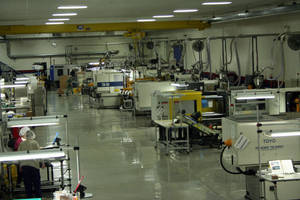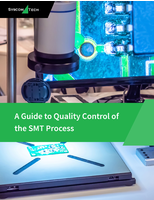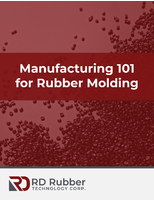Myths for Purchasing Injection Molds and Injection Molded Parts

This information comes directly from the article "7 Myths on Purchasing Injection Molded Parts and Injection Molds" written by Bill Tobin.
Many companies think the purchasing of a mold is the tooling necessary to produce a part. While correct there are some considerations that need to be made before your purchase.
Myth #1 Always buy the most economical mold. Economical does not necessarily mean the lowest purchase price. (Even if that’s the only budget you’re concerned with.) If you take the lifetime volume of the part multiplied by the part price, add in the tool cost plus 15% for maintenance, then divide by the total lifetime volume you’d get the overall cost of that part. As a second calculation, repeat this using the prices from several quotes. While a mold will probably be between 15-25% of all the money spent on this project, the impact the "high" bidder or the "low" bidder on the total project is minimal. Don’t waste your tooling dollars but consider the overall cost of a mold before placing the job.
The folks you know can probably deliver the best tool because they know you. Going to someone you've never done business with or can't give you a good feeling about being a good match is going to be an expensive education.  Calculate the total cost of the mold – even though travel is "Not my budget", placing a job in Singapore is usually an invitation for a Road Trip for everyone with Manager on his business card.  Keep in mind how many days/person will be spent on following up etc. Also remember the money spent on trips is coming from the company profits regardless how the bookies try to hide it somewhere else.  Once the mold is released from the mold maker and sent to the molder, who will do the tweaking to get the mold on-line? Who will do the maintenance if they are not the original builder? Who controls the designs or CAD/CAM drawings so that replacement parts can be manufactured?
Myth #2 Molds have an infinite life. An injection mold is a lot like your car. It wears out with disuse or misuse or use.
Molds are made of steel unless you are in area where the humidity is consistently below 10% where condensation will not form the molds will rust. You need to seek out a molder who will preserve your tool rust and time. This means using mold preservative after every use and wrapping it in a moisture barrier if it is to be stored for a long period of time.
Visit your molder, they come in all flavors.
If the place looks like the bottom of a trash dumpster – cat litter under every machine, parts on the floor, grease everywhere and NOISE; you are dealing with a low cost low quality molder. If your runs are short and you have little need for precision this is the shop for you.
If your molder asks you to put on a paper hat, lab coat and booties; the machines are quietly humming, the place is clean enough to do brain surgery; you’ve got a very precision oriented probably ultrahigh volume molder. All this overhead is spendy but if you want your tools to last for more than 10 million cycles this shop might be for you.
If the shop floor is clean, you frequently notice robots and the few operators present seem to know what they are doing, you are probably in what is generally considered a custom molder. This shop is usually very contentious about quality, delivery and maintenance and can deliver normal maintenance without destroying your mold.
Molds wear out over time.
Maintenance is something that cannot be avoided and somebody has to pay for it. As part of your procedure make sure there is a listing of what you and your molder consider "disposables". These are components covered under the umbrella of routine maintenance. Also make sure you have an understanding of what will be considered general and major maintenance. These last two categories can add up to as much as 30% of the mold's original purchase price. However they can extend the life of the mold by orders of magnitudes. Just like having a spare tire in your car, if your part has any substantial lifetime volume (more than 100,000 pieces) it is in your best interest to have 10% spare cavities in the event of a crash. Making the cavities at the same time the mold is constructed is considerably cheaper than having a cavity custom made.
Myth #4 Your engineering and purchasing staff is qualified to buy a mold. Injection molding, building and qualifying a mold is a skill by itself. Smart companies "partner": they bring the molder in as a consultant during the design phase. Then the mold build contract and molding production is awarded to him as payment for this consulting. Buyers consistently think they can beat up a molder/mold maker for a lower cost. It is common tactic for a buyer, just before sourcing a job, to cross quote this partnering company, just to keep them honest. Was this partnering dishonest? Neither buyers nor engineers understand that this stunt is a lesson learned very quickly by the molder. The next time you ask for a partner you may be asked to look elsewhere or ask for a purchase order for services rendered. If you don't have your own talent and want to competitively bid the project, hire a consultant or treat your partner like a partner.
Myth #5 There are 10 guys in the lobby who can do the job 15% cheaper. If they could, they would. Talk is cheap but you can neither afford to lose time or money to find out. Perfect parts (parts that work), On time (per the schedule), Every time (with a consistent history of performance) at an Economical cost (the low bidder not the parts that have been air freighted because somebody got the schedule wrong) is the expectation of every buyer. But before anything else On Time Delivery is everything. Get a buyer out of earshot of the executives and you’ll be told while the bottom line is everything, he would gladly pay between 10-15% more if there was a guarantee of on time delivery. When picking a shop, look for people who are busy meaning they aren't underbidding the job to avoid bankruptcy but not overloaded where they can’t grow with you. Have your molder show you they can both manage and have the capacity to support your program.
Myth #6 Giving the molder a task to become more productive keeps him competitive. Productivity improvements are good: they lower costs and open available production capacity but who should pay for it? If it's a huge piece of capital equipment, the molder should pay the customer for it out of the savings generated by the purchase made by his customer. Perhaps it should be a 50:50 split. Tasks should be viewed in the framework of Partners. Both parties must benefit. Asking your molder to invest in equipment to make him more productive and then immediately insisting on a price reduction before he's been able to pay for the expense might improve your budget but you've just unfairly burdened him. Just like keeping him honest this is a lesson learned very quickly.
Myth #7 Supplier Management is the key to your company success. A customer can no more manage a supplier than he can control his teenage kids. It's common knowledge that customers have no loyalty and are money-driven. Your suppliers all know your loyalty is a good as your last order. The molder/mold builder started his company because he thought he could run it better his way without the overhead of big business. If not, while their formula for success might not work for you, it works for them. This way you both enjoy a profitable existence.
For the best molding solution, take advantage of Crescent's sixty plus years of experience in the custom injection molding and mold building industry and benefit from their end to end expertise. For more information on Crescent Industries services and capabilities, Visit our website www.crescentind.com or call Toll Free: 1-800-411-3844.




